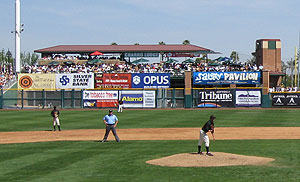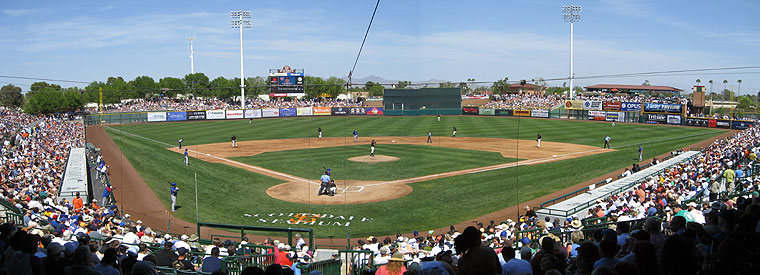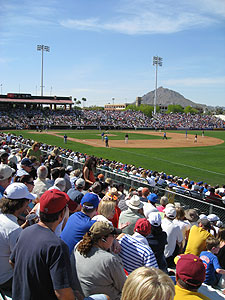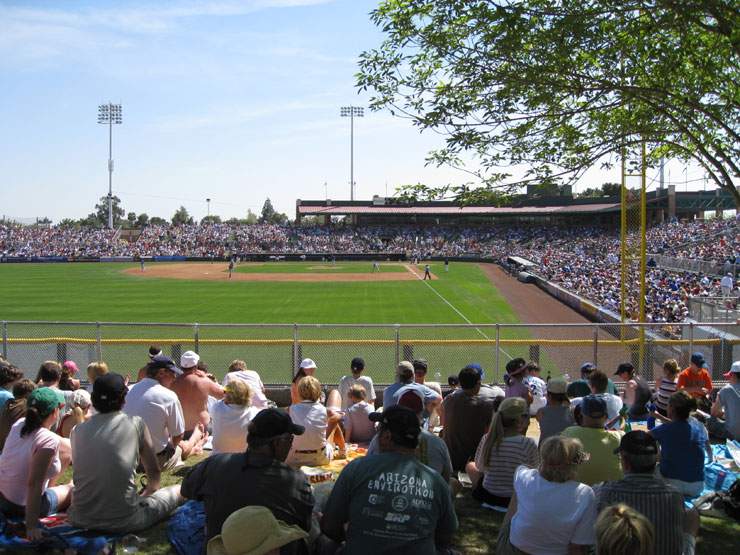
|
The best venue to watch a baseball game at in the Cactus League stands on the corner of Osborn and Drinkwater, where Scottsdale Stadium has resided since 1955.
But the current ballpark looks nothing like the one that stood over five decades ago and first hosted spring training in 1956. That’s because the original was razed after the 1991 spring schedule of games, replaced in less than a year’s time by a new stadium with the same name. When Scottsdale Stadium was reborn in 1992 two things remained unchanged. One was its spring training tenant, the San Francisco Giants. The other was the ballpark’s location on the edge of Old Town Scottsdale. The location of the original was never an issue - the stadium a part of a vibrant downtown, its playing field framed by nearby mountain ranges – so keeping it at the intersections of Osborn Road and Drinkwater Boulevard was the first thing the city did right. Hiring HOK Sport to design the ballpark worked out quite well too. Their efforts produced a great looking ballpark, one built with red brick and dark green wrought iron, on 11 nicely landscaped acres that feature over 200 trees on stadium grounds. A concourse completely encircles the city-owned ballpark. It cuts through the grandstand, where the seats in the upper half (reserved grandstand) are aluminum benches with seatbacks. Traditional seats - plastic chairs all painted green - make up the grandstand’s lower and upper boxes, plus the appropriately named line and outfield box sections that run below the concourse all the way to the ballpark’s foul poles. Sections of bleacher seats are located down both the left and right field lines. The berm is a fan favorite and extends from the left field foul pole into right-center field, where the Charro Lodge was built in 2006 above the Giants’ bullpen. Limited standing room can be found between the right field pole and Charro Lodge, which serves as the stadium’s main hospitality suite. A picnic area for regular folks is on the foul side of the pole in left. The picnic terrace next to the press box is reserved for groups.
All fans have a glimpse of the mountains. Those in the main grandstand are treated to a panorama of the range beyond the outfield, with fans sitting on the first base side of the ballpark enjoying a nice view of the impressive peak behind third base. Just like the mountains, everyone has view of a scoreboard, as Scottsdale Stadium has three. The main scoreboard in left-center is one of the few in spring training to feature a video board. Two small scoreboards are attached to either side of the grandstand’s façade. Fans in the berm can’t help but notice the Scottsdale Healthcare Hospital that hovers behind the ballpark to the left of home plate. Volunteers from the hospital’s 1,200 member Auxiliary force serve as stadium ushers and parking lot attendants. They’re the friendly folks wearing white cowboy hats and light blue shirts. The ballpark is just old enough not to have a main concourse with an open view of the playing field, a modern feature incorporated at ballparks a few years after Scottsdale Stadium was built. As such, the concourse with concession stands and such is located behind the grandstand. So too is the tree-covered Palm Court plaza, which is directly behind home plate where two of the ballpark’s turnstiles are located. The stadium’s main concourse has plaques for all the inductees of the Scottsdale Sports Hall of Fame and the Arizona Fall League Hall of Fame. The AFL plaques are a who’s who of the stars in the game today, while the Scottsdale HOF celebrates local athletes from all sports and Scottdale High's Jim Palmer is the only name most fans will recognize. Just like the athletes celebrated in its concourse, Scottsdale's ballpark is worthy of praise. Packed with trendy amenities and surrounded by wonderful natural scenery, Scottsdale Stadium is a baseball paradise that fans look forward to visiting every March. Although it’s urban location makes parking a hassle, the upscale looking stadium is a perfect fit in a city known for its ritzy resorts.
Location and ParkingThe ballpark is crammed into downtown directly across the street from the Scottsdale Healthcare Hospital. Shops, restaurants, clubs, museums and art galleries are all located a short walk away. Two restaurants of note for baseball fans are the Pink Pony and Don and Charlie's. Both have been frequented by ballplayers and baseball men for decades. Although there's plenty to do before or after the game, parking can be problematic. Spaces at the stadium are almost non-existent and those nearby are limited and often reserved for the hospital. Parking closest to the ballpark fills up quickly, as the Giants are one of the Cactus League's top draws. The further you're willing to walk, the easier it is to find spaces in downtown. If you park far enough away you can do so for free. The entire area is safe, so there's no need to worry about your car. One alternative to searching for a place to park is to take the Giants' Trolley Shuttle, which is free and drops fans off at the main gate. Fans can catch the shuttle on the east side of the Nordstrom parking garage on Marshall Way or on the north side of the downtown parking garage at 5th Avenue and Craftsman Court. The shuttle begins its runs 90 minutes prior to each game and departs every 10 minutes. Return service is provided for 30 minutes following the game. More information is available by calling 480-312-7696. The Scottsdale Charros and Charro Lodge The Charros were formed in 1961 by the Scottsdale Chamber of Commerce "to promote special events in the City of Scottsdale." They have run spring training since 1964, when the original owners of the stadium turned it over to the city with an agreement that the Charros would be responsible for hosting spring training, which has become the organization's primary revenue generator, the proceeds of which are used to fund scholarships and other youth-oriented local charities.
The Charros were formed in 1961 by the Scottsdale Chamber of Commerce "to promote special events in the City of Scottsdale." They have run spring training since 1964, when the original owners of the stadium turned it over to the city with an agreement that the Charros would be responsible for hosting spring training, which has become the organization's primary revenue generator, the proceeds of which are used to fund scholarships and other youth-oriented local charities.
The Charros' have a highly visible presence in Scottsdale Stadium, as their sizable Charro Lodge is behind and above the Giants bullpen in right field. The Lodge is actually split up into two sections: the Pavilion (covered area above the Lodge) and the larger Terrace patio. Admission to the Lodge is usually reserved for groups, but if there is space for that day's game the Charros have a banner that says" Lodge Vacancy Today." For fans that want to take them up on their offer, it costs $75 to "upgrade your day and be part of the party in the Charro Lodge," which includes complimentary food and drink. As for the name "Charros," it was selected to represent Scottsdale's heritage as "The West's Most Western Town," as the city likes to proclaim itself. The group's active membership consists of 40 of Scottsdale's civic and business leaders, each member making a commitment to serve a minimum of seven years and perform more than 240 hours of community service in each. The Charros also have another 150+ life members, which is what members become after serving their seven year commitment.
Scottsdale Stadium HistoryThe Cactus League was in dire straights in 1992, when the eight teams who trained in Arizona primarily did so in outdated facilities. Among them were the Giants and Indians, the two teams responsible for bringing spring training to the state in 1947, and after 45 years the Tribe had decided to head east for new digs in Florida. That prompted then commissioner Fay Vincent to remark, “The Cactus League is struggling. Obviously if teams leave it is not very indicative of a climate where teams are going to want to come.” But that climate was about to change, the seeds to the Cactus League’s current prosperity having already been planted in Scottsdale a few years earlier. In 1989 residents of Scottsdale approved the largest bond issue in city history, and $8.4 million worth of funds were diverted to demolish and rebuild the structure at the corner of Osborn and Drinkwater, where the original Scottsdale Stadium had stood since it was built for $72,000 in 1955. The final game at the old stadium was played on April 3, 1991 and less than a year later a new stadium stood on the same spot ready for use by the Giants, who had trained in Scottsdale since 1982 and agreed to stay through 2008 at the new stadium with the unchanged name. The new ballpark was a gem, replacing the smaller rustic structure that had stood for nearly 40 years prior. Designed by HOK Sport, the firm soon to be famous for their just completed work on Camden Yards, the new Scottsdale Stadium became Arizona’s first modern ballpark when it opened in 1992. Complete with a spacious concourse, berm seating, and a capacity of over 10,000 fans, the new and improved Scottsdale Stadium set the standard for ballparks to come in the Cactus League. The stadium underwent its first major renovations (to the tune of $23.1 million) during 2005, and the Giants agreed to play at the stadium for another 20 years, through 2025, as part of the deal. The most notable changes to the stadium when renovations were completed in 2006 were the construction of a walkway connecting the left and right field berms, plus the creation of the Charro Lodge pavilion and terrace in right field. Previously the Charros had a tent in left field. A full and half practice field was also added east of the stadium, just beyond the right field bleachers.
Scottsdale Stadium Facts, Figures & Footnotes
City Footnotes
| |||||||||||||||||||||||||||||||||||||||||||||||||||||||||||||||||||||||||||||||||||||||||||||||||||||||||||||||||||||||||||||||||||||||


 Two sections of the ballpark get shade. Fans sitting in reserved grandstand seats in front of the press box are protected by its red awning, while those in the left field berm will appreciate the trees planted behind it.
Two sections of the ballpark get shade. Fans sitting in reserved grandstand seats in front of the press box are protected by its red awning, while those in the left field berm will appreciate the trees planted behind it.

